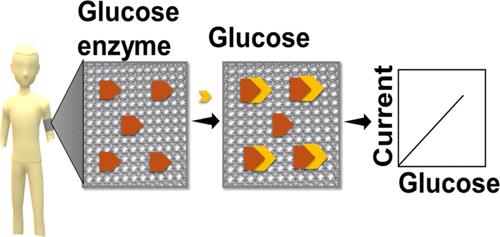实现商用电子纺织品在可穿戴式葡萄糖生物传感应用中的潜力
IF 6.5
Q2 CHEMISTRY, PHYSICAL
引用次数: 0
摘要
可穿戴技术的进步使得利用生物传感器进行无创健康监测成为可能。本研究的重点是利用市场上可买到的导电纺织品开发一种基于纺织品的汗液葡萄糖传感器,从而避免传统制造方法的复杂性。对三种低成本导电纺织品(Adafruit 1364、1167 和 4762)进行了比较分析,利用葡萄糖氧化酶(GOx)和葡萄糖脱氢酶(GDH)等葡萄糖特异性酶进行电化学葡萄糖检测。Adafruit 1364 在形态、电化学和可穿戴特性方面均优于其他产品。循环伏安法显示,Adafruit 1364 和 4762 使用葡萄糖氧化酶可分别在 0.23 V 和 0.08 V 电位下有效检测葡萄糖,使用葡萄糖脱氢酶可分别在 0.1 V 和 0.08 V 电位下有效检测葡萄糖。此外,还进行了时变测量,以确认 1 μM 浓度的葡萄糖的存在。使用浓度为 0.05、0.15、0.25 和 0.5 毫摩尔的葡萄糖溶液进行了差分脉冲伏安法,以评估 Adafruit 1364 织物电极的灵敏度。固定了 GOx 的电极灵敏度为 0.005 μA μM-1,检测限 (LOD) 为 41.3 μM,而固定了 GDH 的电极灵敏度为 0.0019 μA μM-1,检测限为 63.1 μM。该研究还强调了这些传感器的可重复性、干扰物的影响以及良好的可穿戴特性。本文章由计算机程序翻译,如有差异,请以英文原文为准。

Realizing the Potential of Commercial E-Textiles for Wearable Glucose Biosensing Application
Advancements in wearable technology have enabled noninvasive health monitoring using biosensors. This research focuses on developing a textile-based sweat glucose sensor using commercially available conductive textiles, evading the complexity of traditional fabrication methods. A comparative analysis of three low-cost conductive textiles, Adafruit 1364, 1167, and 4762, has been conducted for electrochemical glucose detection with glucose-specific enzymes such as glucose oxidase (GOx) and glucose dehydrogenase (GDH). Adafruit 1364 outperformed others in morphological, electrochemical, and wearable properties. Cyclic voltammetry shows that Adafruit 1364 and 4762 effectively detect glucose at the potential of 0.23 and 0.08 V using glucose oxidase and 0.1 and 0.08 V using glucose dehydrogenase enzymes, respectively. Furthermore, chronoamperometry has been conducted to confirm the presence of glucose at 1 μM concentration. Differential pulse voltammetry was conducted to assess the sensitivity of the Adafruit 1364 fabric electrode using glucose solutions with concentrations of 0.05, 0.15, 0.25, and 0.5 mM. The electrode immobilized with GOx showed a sensitivity of 0.005 μA μM−1 and a limit of detection (LOD) of 41.3 μM, while the electrode immobilized with GDH exhibited a sensitivity of 0.0019 μA μM−1 and an LOD of 63.1 μM. The study also highlighted the reproducibility, effect of interferents, and advantageous wearable properties of these sensors.
求助全文
通过发布文献求助,成功后即可免费获取论文全文。
去求助
来源期刊

ACS Materials Au
材料科学-
CiteScore
5.00
自引率
0.00%
发文量
0
期刊介绍:
ACS Materials Au is an open access journal publishing letters articles reviews and perspectives describing high-quality research at the forefront of fundamental and applied research and at the interface between materials and other disciplines such as chemistry engineering and biology. Papers that showcase multidisciplinary and innovative materials research addressing global challenges are especially welcome. Areas of interest include but are not limited to:Design synthesis characterization and evaluation of forefront and emerging materialsUnderstanding structure property performance relationships and their underlying mechanismsDevelopment of materials for energy environmental biomedical electronic and catalytic applications
 求助内容:
求助内容: 应助结果提醒方式:
应助结果提醒方式:


